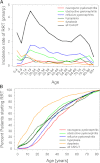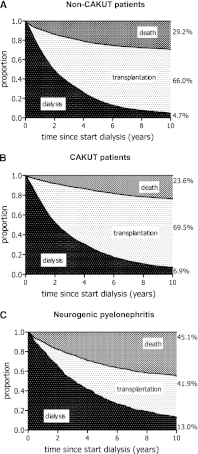Timing and outcome of renal replacement therapy in patients with congenital malformations of the kidney and urinary tract
- PMID: 23085722
- PMCID: PMC3531653
- DOI: 10.2215/CJN.03310412
Timing and outcome of renal replacement therapy in patients with congenital malformations of the kidney and urinary tract
Abstract
Background and objectives: Congenital anomalies of the kidney and urinary tract (CAKUT) are the leading cause of ESRD in children, but the proportion of patients with individual CAKUT entities progressing to ESRD during adulthood and their long-term clinical outcomes are unknown. This study assessed the age at onset of renal replacement therapy (RRT) and patient and renal graft survival in patients with CAKUT across the entire age range.
Design, setting, participants, & measurements: Patients with CAKUT were compared with age-matched patients who were undergoing RRT for other renal disorders on the basis of data from the European Renal Association-European Dialysis and Transplant Association Registry. Competing risk and Cox regression analyses were conducted.
Results: Of 212,930 patients commencing RRT from 1990 to 2009, 4765 (2.2%) had renal diagnoses consistent with CAKUT. The proportion of incident RRT patients with CAKUT decreased from infancy to childhood and then increased until age 15-19 years, followed by a gradual decline throughout adulthood. Median age at RRT start was 31 years in the CAKUT cohort and 61 years in the non-CAKUT cohort (P<0.001). RRT was started earlier (median, 16 years) in patients with isolated renal dysplasia than in those with renal hypoplasia and associated urinary tract disorders (median, 29.5-39.5 years). Patients with CAKUT survived longer than age- and sex-matched non-CAKUT controls because of lower cardiovascular mortality (10-year survival rate, 76.4% versus 70.7%; P<0.001).
Conclusions: CAKUT leads to ESRD more often at adult than pediatric age. Treatment outcomes differ from those of acquired kidney diseases and vary within CAKUT subcategories.
Figures





References
-
- Lewis M, Shaw J, Reid C, Evans J, Webb N, Verrier-Jones K: Demography and management of childhood established renal failure in the UK (chapter 13). Nephrol Dial Transplant 22[Suppl 7]: vii165–vii175, 2007 - PubMed
-
- Ardissino G, Daccò V, Testa S, Bonaudo R, Claris-Appiani A, Taioli E, Marra G, Edefonti A, Sereni F, ItalKid Project : Epidemiology of chronic renal failure in children: Data from the ItalKid project. Pediatrics 111: e382–e387, 2003 - PubMed
-
- Orr NIT, McDonald SP, McTaggart S, Henning P, Craig JC: Frequency, etiology and treatment of childhood end-stage kidney disease in Australia and New Zealand. Pediatr Nephrol 24: 1719–1726, 2009 - PubMed
-
- Mong Hiep TT, Ismaili K, Collart F, Van Damme-Lombaerts R, Godefroid N, Ghuysen MS, Van Hoeck K, Raes A, Janssen F, Robert A: Clinical characteristics and outcomes of children with stage 3-5 chronic kidney disease. Pediatr Nephrol 25: 935–940, 2010 - PubMed
Publication types
MeSH terms
LinkOut - more resources
Full Text Sources
Other Literature Sources
Medical

